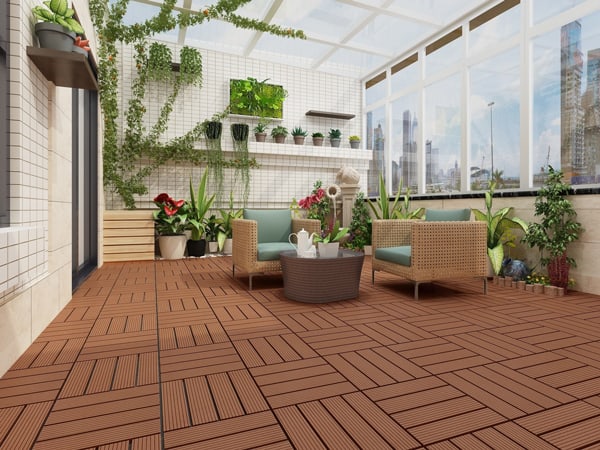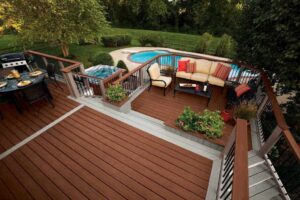In the ever-evolving world of interior and exterior design, innovative materials are constantly reshaping the way we think about our living spaces. One such innovation that has gained significant traction is Wood-Plastic Composite (WPC) tiles. These versatile and eco-friendly tiles have emerged as a game-changer in the flooring and decking industry.
WPC tiles are the result of combining wood fibers, plastics, and various additives to create a resilient and visually appealing product that mimics the look of natural wood. This blend not only offers the aesthetic charm of timber but also boasts several remarkable advantages that have homeowners and designers alike turning their attention to WPC.
What Are WPC Tiles?
WPC tiles, short for Wood-Plastic Composite tiles, are a cutting-edge construction material that combines various elements to create a versatile and eco-friendly product. They are primarily composed of:
Wood Fibers: These are typically sourced from wood waste materials or sawdust. The wood fibers provide WPC tiles with a natural, wood-like appearance.
Plastics: High-quality plastics, often recycled or virgin polyethylene, are mixed with the wood fibers. This plastic component enhances the durability and weather resistance of WPC tiles.
Additives: Various additives are introduced into the mix to improve the overall performance of the tiles. These can include UV stabilizers to prevent fading, colorants for aesthetics, and bonding agents to ensure a strong composite structure.
The combination of these elements results in a robust and low-maintenance material that mimics the look of wood while offering enhanced durability and sustainability. WPC tiles have become a popular choice for both indoor and outdoor applications, revolutionizing the world of flooring and decking.
Eco-Friendly Edge of WPC Tiles
WPC (Wood-Plastic Composite) tiles shine as an eco-conscious choice in the realm of flooring and decking materials. Here’s how they contribute to a greener planet:
Reduced Deforestation: By using wood fibers from sustainable sources and recycling plastics, WPC tiles significantly reduce the demand for fresh timber. This helps preserve forests, vital for biodiversity and climate control.
Less Resource Intensive: The manufacturing process of WPC tiles consumes fewer natural resources compared to traditional wood or plastic alternatives. It curtails energy consumption and lowers the carbon footprint.
Longevity and Low Waste: WPC tiles boast impressive durability and resistance to decay. Their extended lifespan means fewer replacements, reducing waste and landfill burden.
Minimal Maintenance: The low-maintenance nature of WPC tiles translates to fewer environmentally harmful cleaning agents and chemicals being released into the ecosystem.
Recyclability: Many WPC products are recyclable, further promoting a closed-loop approach to material usage.
Advantages and Disadvantages of WPC Tiles
Advantages of WPC Tiles
Durability: WPC (Wood-Plastic Composite) tiles are exceptionally durable, resistant to wear, and can withstand exposure to moisture, making them ideal for high-traffic areas and outdoor use.
Low Maintenance: They require minimal maintenance compared to natural wood, saving you time and effort. Regular cleaning is usually all that’s needed to keep them looking great.
Aesthetics: WPC tiles offer the visual appeal of natural wood with a variety of styles and colors to choose from, enhancing the aesthetics of your space.
Eco-Friendly: These tiles are made using recycled materials and reduce the demand for fresh timber, promoting sustainability and eco-conscious construction.
Easy Installation: Many WPC tile options are designed for DIY installation, simplifying the process and potentially saving on installation costs.
Disadvantages of WPC Tiles
Heat Resistance: While WPC tiles are highly durable, they may not handle extreme heat as well as some other materials. Direct exposure to intense sunlight can cause expansion or warping.
Initial Cost: The upfront cost of WPC tiles can be higher compared to some alternatives like traditional wood or basic ceramic tiles. However, their long-term durability can offset this initial expense.
In summary, WPC tiles offer durability, low maintenance, and an eco-friendly approach, but they may have limitations in terms of heat resistance and initial cost. Choosing WPC tiles depends on your specific needs and budget, but they often prove to be a valuable investment in the long run.
Is WPC Tiles wood or plastic?
WPC Tiles , or Wood-Plastic Composite, is a material that incorporates elements of both wood and plastic in its composition. It’s neither purely wood nor entirely plastic but rather a synergistic blend of these two materials.
In the formulation of WPC, wood fibers, often sourced from wood waste or sawdust, are combined with high-quality plastics, typically recycled or virgin polyethylene. This combination harnesses the desirable characteristics of each component. The wood provides a natural and aesthetic appearance, mimicking the look of real wood, while the plastic enhances durability, weather resistance, and overall longevity.
WPC’s hybrid nature offers numerous benefits, including eco-friendliness by reducing the demand for fresh timber, exceptional durability, and a low-maintenance profile. It’s an innovative solution that caters to both environmental concerns and the need for robust and attractive materials in various applications, from flooring to decking and beyond.
WPC Tiles vs. Plywood Cost Comparison
WPC (Wood-Plastic Composite):
Initial Cost: Generally, the upfront cost of WPC boards or products is higher than that of plywood. The cost may vary depending on the brand, quality, and specific product.
Installation: WPC products often have simpler and quicker installation processes, potentially reducing labor costs.
Maintenance: WPC Tiles requires minimal maintenance, which can lead to long-term cost savings due to reduced upkeep expenses.
Durability: WPC Tiles offers excellent durability and resistance to moisture, which can extend its lifespan and reduce replacement costs over time.
Plywood:
Initial Cost: Plywood is usually more budget-friendly upfront, making it a popular choice for cost-conscious projects.
Installation: The installation of plywood may be more labor-intensive and time-consuming, potentially increasing labor costs.
Maintenance: Plywood typically requires more maintenance, including sealing or painting, which can lead to additional expenses over time.
Durability: Plywood is vulnerable to moisture damage and may need replacement or repairs sooner in wet or humid environments, potentially adding to long-term costs.
In summary, while WPC products may have a higher initial cost compared to plywood, they often offer advantages in terms of durability and reduced long-term maintenance expenses. The choice between WPC and plywood depends on your specific project requirements, budget constraints, and the intended use of the material.
Maintenance and Cleaning Tips
Cleaning and Maintaining Your WPC Tiles
WPC (Wood-Plastic Composite) tiles are renowned for their low-maintenance nature, but proper care can ensure they remain attractive and durable for years. Here are some practical tips for cleaning and maintaining WPC tiles:
- Regular Sweeping: Start by regularly sweeping or vacuuming your WPC tiles to remove loose dirt and debris. This simple step prevents scratches and maintains their appearance.
- Mild Soap and Water: For deeper cleaning, mix a solution of mild soap and warm water. Use a soft-bristle brush or mop to gently scrub the tiles. Avoid harsh chemicals or abrasive cleaners, as they can damage the surface.
- Rinse Thoroughly: After cleaning with soap and water, rinse the tiles thoroughly to remove any soap residue. Ensure the tiles are completely dry before using the area again.
- Stain Removal: For stubborn stains, consider using a mixture of vinegar and water or a specialized WPC cleaner. Always follow the manufacturer’s instructions for any cleaning products.
- Preventive Measures: To avoid potential damage, place doormats at entrances to trap dirt and moisture. Furniture legs should have protective pads to prevent scratching.
- Avoid Heat Exposure: Be cautious with hot objects like grills or fire pits. Use protective pads or mats under such items to prevent heat-induced damage.
- Snow and Ice Removal: In cold climates, avoid using metal shovels or sharp tools to remove snow and ice. Instead, opt for plastic or rubber shovels to prevent scratching.
- Regular Inspection: Periodically check for loose tiles or damaged edges. If any issues arise, address them promptly to prevent further damage.
- Avoid Heavy Impact: Although WPC tiles are durable, they can be damaged by heavy objects. Take care when moving or placing heavy furniture or equipment on them.
- UV Protection: While WPC tiles are UV-resistant, prolonged exposure to direct sunlight can lead to slight fading over time. Consider using outdoor rugs or shades to protect them from excessive sun exposure.
By following these practical guidelines, you can keep your WPC tiles looking pristine and ensure they remain a long-lasting, attractive addition to your space.
Conclusion
In the realm of modern construction materials, WPC (Wood-Plastic Composite) tiles have emerged as a transformative force. These versatile tiles seamlessly blend the natural charm of wood with the durability of plastic, offering a myriad of benefits that redefine our approach to flooring and decking.
The advantages of WPC tiles are abundant, from their exceptional durability and low-maintenance nature to their eco-friendly composition. They stand as a testament to sustainable design, reducing the demand for fresh timber while providing a robust and long-lasting solution for both indoor and outdoor spaces.
While they may come with a slightly higher initial cost, the long-term savings in maintenance and replacement expenses make them a wise investment. WPC tiles not only enhance the aesthetics of your home but also contribute to a greener, more sustainable future.
So, whether you’re considering a renovation project or a new construction endeavor, consider WPC tiles as a testament to innovation, longevity, and eco-conscious living. With WPC, you’re not just upgrading your space; you’re elevating your lifestyle.





